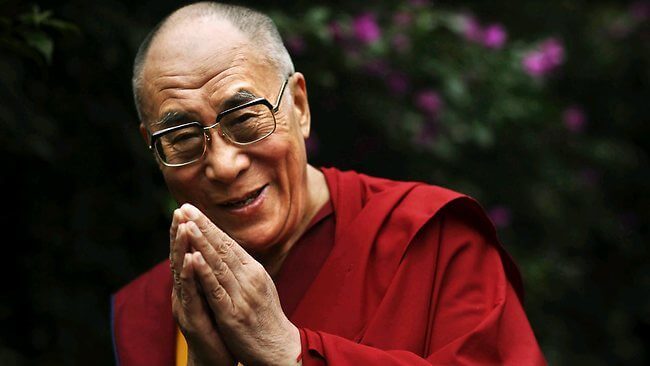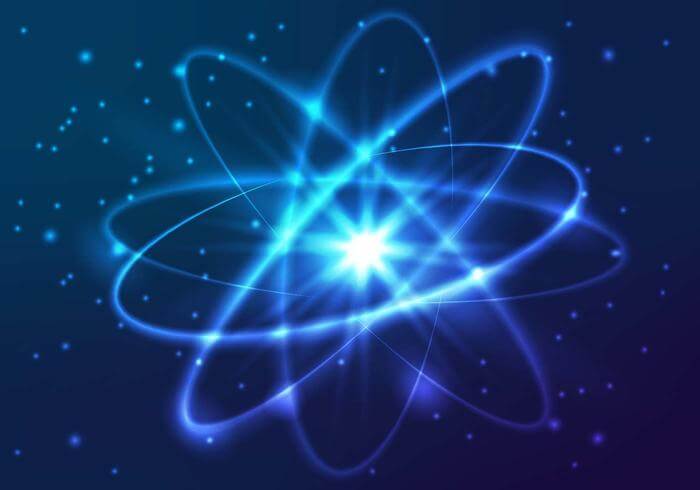There's a Connection Between Quantum Physics and Spirituality


Written and verified by the psychologist Sergio De Dios González
The connection between quantum physics and spirituality is obvious to the Dalai Lama. In fact, according to him, all the atoms in our bodies include part of the ancient canvas that made up the Universe in the past. In effect, we’re stardust and biologically connected to any living being, beings of invisible energy that vibrate. Entities that are united with everything in existence.
If there’s one thing that we all know, it’s that science and spirituality aren’t exactly renowned for agreeing with each other. For example, in the Middle Ages and the Renaissance, it was highly dangerous to progress in the scientific field, since the context was dominated by the ecclesiastical class. Take, for example, the sad story of Giordano Bruno. On the other hand, nowadays, many spiritual approaches tend to feel criticized by the scientific world.
Therefore, to hear that these two traditionally antagonistic areas or universes of our society have agreed on something may seem rather bizarre. However, it does appear that there are certain positions upon which their ideas converge. This obviously invites some reflection. We’re talking here about Buddhist philosophy and quantum mechanics.
The Dalai Lama
In 2015, in New Delhi, the Dalai Lama attended a two-day conference on quantum physics and Madhyamaka philosophy. Here, a number of relevant physicists and scientists from various fields explored a wide variety of topics in order to try and discover some common ground. This was in an attempt to further enrich human knowledge.
“When I was about 19 or 20 years old I developed a great curiosity about science. In China, during the years 1954 and 1955, I met Mao Zedong. He once praised me for having a scientific mind, adding that religion was poison, expecting maybe that would attract someone who had a scientific mind. However, more than 30 years ago I began a series of dialogues focused on cosmology, neurobiology, physics, including quantum physics and psychology… I think that Buddhism brings more meaning to all this knowledge.”
-Dalai Lama-

The connection between quantum physics and spirituality
The theories that establish a connection between quantum physics and spirituality are not new. Nor do they come from the Dalai Lama alone. For example, there are books such as Science and Spirituality: A Quantum Integration by Amit Goswami. He’s a retired professor in the Department of Theoretical Physics at the University of Oregon and pioneer of a new scientific paradigm that seeks to lay the foundations of a science of consciousness.
Likewise, there’s Fritjof Capra, a renowned Austrian physicist researcher in subatomic physics. In fact, this scientist is known for his work, The Tao of Physics (1975), which led to a lukewarm opening by the academic world towards the spiritual world. We can therefore say quite confidently that there’s a clear rapprochement between the scientific community and Buddhist philosophy.
Raja Ramanna was a physicist who died a few years ago. He was best known for his role in the nuclear development of India. In his last days, he took an interest in the texts of the philosopher Nagarjuna. He discovered something astonishing. This was the fact that many of the statements of the founder of the Madhyamaka school of Majaian Buddhism touched on certain principles of quantum physics.
Let’s take a closer look at these commonalities, the principles that the Dalai Lama spoke about in his 2015 conference in India.
Quantum physics
- The term ‘quantum’ is the smallest unit that makes up light. Thus, what quantum mechanics seeks above all is to be able to understand the phenomenology of the atom, and all those elementary particles that compose it.
- This is a science that began around the beginning of the twentieth century, where names such as Max Planck established a large part of the theories that are around today.
- It’s a discipline that’s as striking as it’s complex. In fact, it aspires to define and understand what isn’t seen, what can’t be measured, and all the indeterminism inscribed in the particles that make up our reality. One thing that quantum physics has established is that if you could see an atom under a microscope, what you’d discover is a small tornado. A vortex where quarks and photons rotate.
As a matter of fact, if you got a little closer to them you’d discover something even more striking. A void. Because atoms have no physical structure, and what they’re actually made up of is invisible energy, not tangible matter. In fact, the idea that we’re energy is one of the pillars that make up the connection between quantum physics and spirituality.

A consciousness that goes beyond the physical
Today, in almost any store, you can find endless books with the term ‘quantum’. For example, there’s quantum computing’, ‘quantum mind’, ‘quantum psychology’, ‘quantum healing’… Indeed, it’s as if this mysterious microworld has suddenly started to orchestrate many of our daily activities.
However, the connection between quantum physics and spirituality remains one of the most relevant for those principles that the Dalai Lama established during his conference in India.
- Quantum physics shows us that beyond everything tangible and material there exists energy. In fact, Buddhism has always defended this idea and the need of transcending the physical to give greater relevance to our consciousness. After all, it’s that psychic imprint that gives meaning and shape to reality itself. We are what we think, and it’s thought itself that designs what surrounds us.
A creative mind
- Amit Goswami, the aforementioned professor of physics at the University of Oregon claims that the behavior of microparticles changes depending on what the observer does. When an observer looks, a type of wave appears. If they don’t act, it doesn’t change.
This shows how sensitive atoms are to everything that we do. However, Buddhism has always claimed this to be the case. Indeed, it suggests that our emotions and thoughts define us and the reality that surrounds us.
Universal connection
In each of our atoms resides part of that stardust with which the universe itself originated. Somehow, as the Dalai Lama tells us, we’re all connected and all come from the same essence. Conceiving this connection can help us understand the importance of generating good. That’s because everything we do reverberates in the Universe and is ultimately returned to us.
In conclusion, the connection between quantum physics and spirituality invites us to see this area of science through another lens. Although it’s merely suggestive at this stage, and it certainly won’t be acceptable to the most orthodox and rigorous minds, it certainly invites reflection.
“If we think about the possible connection between quantum physics and spirituality, we can see that the mind would no longer be that accidental intruder in the realm of matter, but would rather rise as a creator and governing entity of the realm of matter.”
-R.C. Henry, The Mental Universe –
The connection between quantum physics and spirituality is obvious to the Dalai Lama. In fact, according to him, all the atoms in our bodies include part of the ancient canvas that made up the Universe in the past. In effect, we’re stardust and biologically connected to any living being, beings of invisible energy that vibrate. Entities that are united with everything in existence.
If there’s one thing that we all know, it’s that science and spirituality aren’t exactly renowned for agreeing with each other. For example, in the Middle Ages and the Renaissance, it was highly dangerous to progress in the scientific field, since the context was dominated by the ecclesiastical class. Take, for example, the sad story of Giordano Bruno. On the other hand, nowadays, many spiritual approaches tend to feel criticized by the scientific world.
Therefore, to hear that these two traditionally antagonistic areas or universes of our society have agreed on something may seem rather bizarre. However, it does appear that there are certain positions upon which their ideas converge. This obviously invites some reflection. We’re talking here about Buddhist philosophy and quantum mechanics.
The Dalai Lama
In 2015, in New Delhi, the Dalai Lama attended a two-day conference on quantum physics and Madhyamaka philosophy. Here, a number of relevant physicists and scientists from various fields explored a wide variety of topics in order to try and discover some common ground. This was in an attempt to further enrich human knowledge.
“When I was about 19 or 20 years old I developed a great curiosity about science. In China, during the years 1954 and 1955, I met Mao Zedong. He once praised me for having a scientific mind, adding that religion was poison, expecting maybe that would attract someone who had a scientific mind. However, more than 30 years ago I began a series of dialogues focused on cosmology, neurobiology, physics, including quantum physics and psychology… I think that Buddhism brings more meaning to all this knowledge.”
-Dalai Lama-

The connection between quantum physics and spirituality
The theories that establish a connection between quantum physics and spirituality are not new. Nor do they come from the Dalai Lama alone. For example, there are books such as Science and Spirituality: A Quantum Integration by Amit Goswami. He’s a retired professor in the Department of Theoretical Physics at the University of Oregon and pioneer of a new scientific paradigm that seeks to lay the foundations of a science of consciousness.
Likewise, there’s Fritjof Capra, a renowned Austrian physicist researcher in subatomic physics. In fact, this scientist is known for his work, The Tao of Physics (1975), which led to a lukewarm opening by the academic world towards the spiritual world. We can therefore say quite confidently that there’s a clear rapprochement between the scientific community and Buddhist philosophy.
Raja Ramanna was a physicist who died a few years ago. He was best known for his role in the nuclear development of India. In his last days, he took an interest in the texts of the philosopher Nagarjuna. He discovered something astonishing. This was the fact that many of the statements of the founder of the Madhyamaka school of Majaian Buddhism touched on certain principles of quantum physics.
Let’s take a closer look at these commonalities, the principles that the Dalai Lama spoke about in his 2015 conference in India.
Quantum physics
- The term ‘quantum’ is the smallest unit that makes up light. Thus, what quantum mechanics seeks above all is to be able to understand the phenomenology of the atom, and all those elementary particles that compose it.
- This is a science that began around the beginning of the twentieth century, where names such as Max Planck established a large part of the theories that are around today.
- It’s a discipline that’s as striking as it’s complex. In fact, it aspires to define and understand what isn’t seen, what can’t be measured, and all the indeterminism inscribed in the particles that make up our reality. One thing that quantum physics has established is that if you could see an atom under a microscope, what you’d discover is a small tornado. A vortex where quarks and photons rotate.
As a matter of fact, if you got a little closer to them you’d discover something even more striking. A void. Because atoms have no physical structure, and what they’re actually made up of is invisible energy, not tangible matter. In fact, the idea that we’re energy is one of the pillars that make up the connection between quantum physics and spirituality.

A consciousness that goes beyond the physical
Today, in almost any store, you can find endless books with the term ‘quantum’. For example, there’s quantum computing’, ‘quantum mind’, ‘quantum psychology’, ‘quantum healing’… Indeed, it’s as if this mysterious microworld has suddenly started to orchestrate many of our daily activities.
However, the connection between quantum physics and spirituality remains one of the most relevant for those principles that the Dalai Lama established during his conference in India.
- Quantum physics shows us that beyond everything tangible and material there exists energy. In fact, Buddhism has always defended this idea and the need of transcending the physical to give greater relevance to our consciousness. After all, it’s that psychic imprint that gives meaning and shape to reality itself. We are what we think, and it’s thought itself that designs what surrounds us.
A creative mind
- Amit Goswami, the aforementioned professor of physics at the University of Oregon claims that the behavior of microparticles changes depending on what the observer does. When an observer looks, a type of wave appears. If they don’t act, it doesn’t change.
This shows how sensitive atoms are to everything that we do. However, Buddhism has always claimed this to be the case. Indeed, it suggests that our emotions and thoughts define us and the reality that surrounds us.
Universal connection
In each of our atoms resides part of that stardust with which the universe itself originated. Somehow, as the Dalai Lama tells us, we’re all connected and all come from the same essence. Conceiving this connection can help us understand the importance of generating good. That’s because everything we do reverberates in the Universe and is ultimately returned to us.
In conclusion, the connection between quantum physics and spirituality invites us to see this area of science through another lens. Although it’s merely suggestive at this stage, and it certainly won’t be acceptable to the most orthodox and rigorous minds, it certainly invites reflection.
“If we think about the possible connection between quantum physics and spirituality, we can see that the mind would no longer be that accidental intruder in the realm of matter, but would rather rise as a creator and governing entity of the realm of matter.”
-R.C. Henry, The Mental Universe –
All cited sources were thoroughly reviewed by our team to ensure their quality, reliability, currency, and validity. The bibliography of this article was considered reliable and of academic or scientific accuracy.
- Forman, R. (1998). Mystical consciousness, the innate capacity and the perennial psychology. En R. K. C. Forman (Ed.), The Innate Capacity: Mysticism, Psychology, and Philosophy, Journal of Human Values (pp. 3–44) https://philpapers.org/rec/FORMCT
- Henry, R. C. (2005). The mental universe. Nature, 436(7047), 29. https://www.nature.com/articles/436029a
- Koestler, Arthur (1994). Las raíces del azar. Kairós
- Lama, Dalai (2007) El Universo en un solo átomo: Madrid: DeBolsillo
- Goswame, Amit (2011) Ciencia y espiritualidad: una integración cuántica. Kairós.
- Ponte DV, Schäfer L. (2013) Carl Gustav Jung, quantum physics and the spiritual mind: a mystical vision of the twenty-first century. Behavioral Sciences. Nov 13;3(4):601-618. https://www.ncbi.nlm.nih.gov/pmc/articles/PMC4217602/
- Tacey, D. 2004. The Spirituality Revolution. Hove: Brunner Routledge
- Walton, J. (2017). The significance of consciousness studies and quantum physics for researching spirituality. Journal for the Study of Spirituality, 7(1), 21–34. https://www.tandfonline.com/doi/abs/10.1080/20440243.2017.1290029?journalCode=yjss20
- Wallace, B. A. 2013. Meditations of a Buddhist Skeptic: A Manifesto for the Mind Sciences and
Contemplative Practice. New York: Columbia University Press - Walker, E. H. (2000). The physics of consciousness: The quantum mind and the meaning of life. Perseus.
This text is provided for informational purposes only and does not replace consultation with a professional. If in doubt, consult your specialist.







